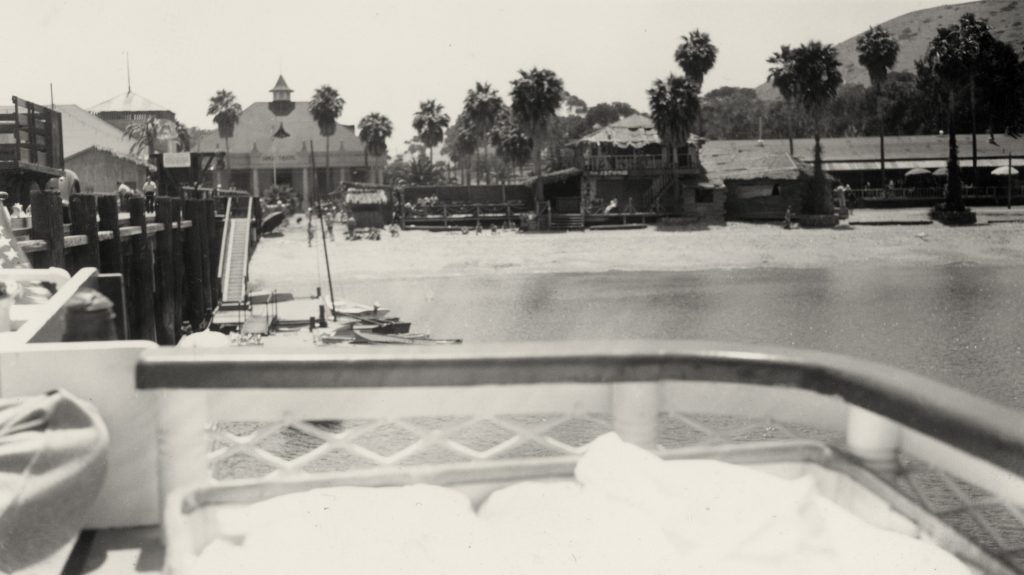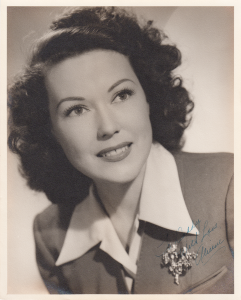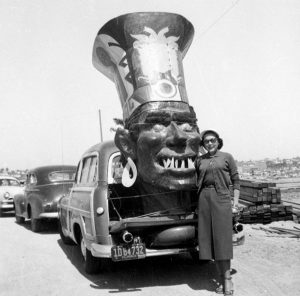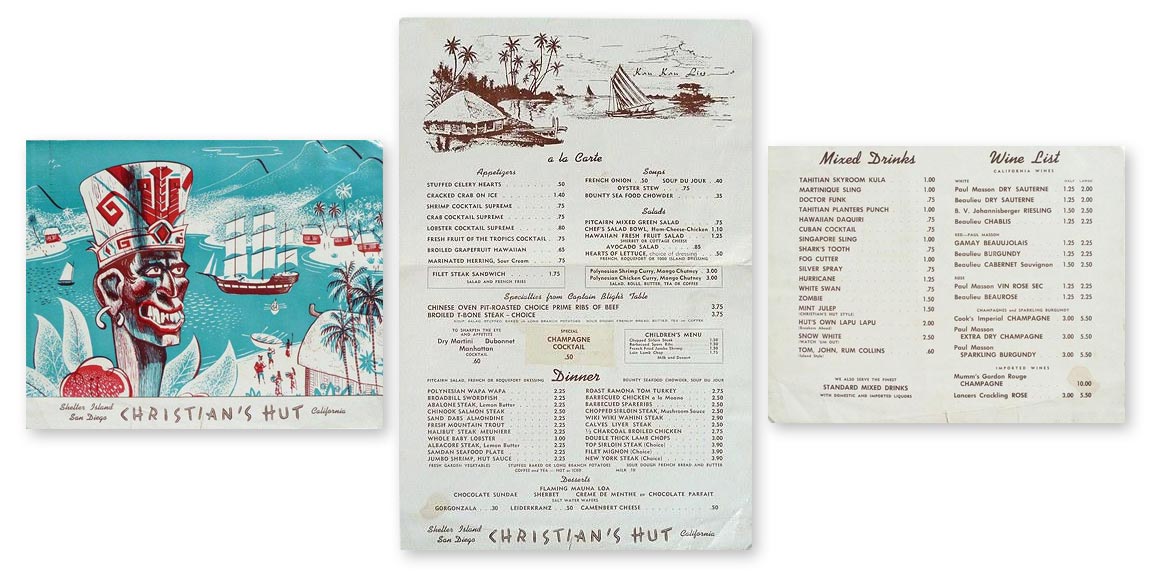
Christian’s Hut / The Hut (1953-1954), before it was Bali Hai, it was The Hut…
At the time Christian’s Hut opened in San Diego, entrepreneur Arthur LaShelle operated Christian’s Huts in Newport Beach and Laguna Beach. He’d based the tropical restaurant on the original he opened on Catalina Island in 1935.
The ‘Beau Brummel’ of Catalina
Arthur Gregg Wellington LaShelle (1903-1985) began his career as an assistant cameraman for Paramount Famous Lasky Corporation in the 1920s. His older brother Joseph Wellington LaShelle (1900-1989) was a busy camera operator for Paramount Studios, and rose to become an Oscar-winning cinematographer (Laura). Joe probably got him that job. Although Art started modestly working ‘in pictures,’ he soon found himself an early resident of beautiful Santa Catalina Island, catering to the Hollywood elite.In 1928 Art managed the Riviera Theater in Avalon for Tom White, a Hollywood promoter. Chewing gum magnate William Wrigley, whose Santa Catalina Island Company controlled the island, bought a construction business owned by Charles M LaShelle, moved its heavy equipment over to the island, and built the Avalon Casino. White became general manager of the new Casino, but ‘his lifestyle proved too flamboyant,’ and his association Wrigley ended in December 1929. Art LaShelle then managed both the Riviera and Avalon theatres until 1939. He was responsible for booking acts for the ballroom, films and the like.
After becoming a ‘confidant’ of William Wrigley, Art ran operations on the Isthmus (a remote spot on the island favored by Hollywood studios) for 10 years. Two Harbors on the Isthmus became a favorite filming location. It was an economical stand-in for the Polynesian islands — and a great place to party!
Cutting a dashing young figure with his ever-present pipe, fast wit and debonaire style, LaShelle easily mingled with Hollywood stars visiting or working on the island. There was always a film crew or two hanging around. And they needed to be entertained, boarded and fed.
Mistah Christian!
Parts of MGM’s Mutiny on the Bounty starring Charles Laughton and Clark Gable were filmed in Tahiti at great expense. Full-sized replicas of the Bounty and the Pandora were built. 2500 Tahitian extras were hired. Over half a million feet of film was shot. But many scenes with principal actors were shot much closer to Hollywood, on the Isthmus of Catalina Island in that Summer of 1934. Producers found it much easier to manage all the egos when closer to home — Laughton and Gable didn’t get along too well. Local Catalina kids were cast as extras. The girls knew of Gable’s habit of draping his arm over a shoulder, and snapped pics with their Brownies when it would inevitably occur. Over the four-month shooting schedule LaShelle and Gable became close friends, and Art was once even Gable’s double.
LaShelle managed things on the Isthmus for Wrigley, including land, beach and bay that MGM leased for the shoot. A building on the beach served as a cocktail lounge for cast and crew. It became known as Christian’s Hut. Clark Gable is said to have lived in rooms above the bar. And the bartender was none other than Ray Buhen (Don the Beachcomber, Tiki Ti).When filming wrapped, LaShelle ‘offered to save the studio the expense of dismantling the beach shacks and props.’ Art said he’d fix up the beachside hut and make it into a bar.
“So we did, Gable said we would have to call it Christian’s Hut, because it was there as Fletcher Christian, that Gable and I used to end the day with a number of highballs. Gable autographed a picture to me, signing himself as ‘the Proprietor’ of Christian’s Hut.”
Christian’s Hut remained open after the shoot, and Ray Buhen was hired to tend bar. LaShelle and ‘a fellow named Joe Guido’ operated the Hut for years. Papeete Beach became the happening spot on the Isthmus for visiting yachtsfolks.
“Jean Harlow and Charles Laughton were regulars, along with most of John Ford’s stock company. According to Ray, the biggest and baddest of these was Victor McLaglen. During his Hut hitch, Ray saw John Wayne and Ward Bond both back down when McLaglen offered to take them on.”
LaShelle’s second son Rod said that they didn’t really know their father that well. Not that much of a family man, and that Art was known by many as a womanizer. He’d been going around with fiery actress Lupe Vélez ever since she dumped Johnny Weissmuller for him — all the while Art was married to Muriel Frost Hewitson Landman. When asked, he told gossip maven Louella Parsons there was ‘never a dull moment with Lupe’ and that his nine-year-old son Art Jr was ‘completely captivated by her.’ Needless to say his wife sued for divorce. By the Summer of 1940 Art was renting a small apartment in Beverly Hills next to Bö Roos. Perhaps Bö set him up with it until he could get back on his feet, or it might have been a secret hideaway. In the Fall, he was running a restaurant called Catalina John’s on the Miracle Mile in Los Angeles.
To top things off, the original Christian’s Hut burned down three days before Thanksgiving.
He re-opened in Newport Beach on Balboa Bay, this time near the Balboa Bay Club. Old yachting buddies who visited the Hut would be close enough to easily stumble home. He lived at the club himself for twenty-eight years or so.
LaShelle served as a pilot for the Air Transport Command in WWII. After the war ended, he leased and operated the entire Isthmus on Catalina, and opened up several more Christian’s Hut restaurants.
Workin’ the Connections
To finance his projects, Art went to childhood friend and Hollywood ‘business manager to the stars’ Bö Christian Roos, who invested funds from several of his clients including Fred MacMurray, John Wayne and Red Skelton. Roos would routinely invest his money alongside that of his clients, most times on a simple handshake. Old-school, no contracts.With these investors, LaShelle opened up Christian’s Hut restaurants in Newport Beach overlooking Balboa Bay, in Laguna Beach on Pacific Coast Highway, and in Honolulu. (Other locations were later in Corona del Mar and possibly Bangladesh.)
LaShelle developed the San Diego location with friend Aline Hudson. His other locations had all been remodels of existing structures. Huts. Palm fronds. Fishing nets. Sand floors. The San Diego Hut would be their masterpiece. A modern glass hut. Built from the ground up on a brand-spanking-new island.
In 1952 LaShelle signed a lease in his name with the San Diego City Harbor Department to build another of his tiki restaurants on the newly developed Polynesian-themed Shelter Island. Slick renderings by R Benedict Brout & Associates (which also designed Yacht Landing, in Oceanside Harbor) showed a round, two-story, glass-walled tiki-modern building surrounded with docks for visiting boats. A printed prospectus for the project promised that “fountain lights, on floating barges, would mark the end of each pier” and a landmark light would “beam skyward from a replica of Tahiti’s God Ramu…”
It’s just what the Harbor Commissioners wanted to see. Big names in San Diego wanted to make the Shelter Island marina as successful as Balboa Bay and and Newport Harbor. Port Director John Bate ran it through the approval process quickly, as he’d been stalled before by the City Council on several other proposals.
If the design seems familiar, it is!
LaShelle blended his love of Polynesian grass shack style with that of his workplace of many years — the Avalon Casino on Catalina. Although the Casino is Mediterranean art deco, both are multi-storied circular buildings with similar rooflines, surrounded on three sides by ocean.
The restaurant was begrudgingly given the go-ahead by the City Council – the Mayor and some Councilmen were bent out of shape about not being informed by Port Director John Bate. They found out about the lease in the local newspaper.
Hollywood Spitfire
Aline Hudson (1911-2001) was born Margaret Alieene Shook, in Long Beach, to Albert Muhleman Shook and Cora MuCullough Shook. In her early years, Aline grew up in San Diego. She and her family lived next to that of Carlo Pastore (Pastore’s, Caesar’s).Her father Al was a stockbroker, real estate man, attorney, and for many years, a trustee in San Diego bankruptcy court. He started out in pre-WWI Long Beach selling stock for the ‘Peace Maker’ submarine by the Los Angeles Submarine Boat Company. Married Cora McCullough, a widow with a small son. It was there several years later they had a daughter. Al was a conservative, by-the-numbers kinda guy who probably wanted a son and so named his daughter after himself. He was always wheeling and dealing real estate, whether for bankruptcy, foreclosure or investment. They lived well.
His sister’s husband was a retired major from the Spanish American War named Hubert Fay. A city councilman down in San Diego. Lots of good real estate deals and opportunities were to be had if he moved, so Al did. He became friends with three sisters in an old San Diego farming family, the Guatellis. Al invested in several properties with one of the sisters, Leonora Guatelli. She was a longtime employee of the largest drugstore chain in San Diego, Ferris and Ferris, and would later own the drugstore — and Al. Turns out Leonora and Al had been having a longtime affair.
 Cora divorced Al. From then on, Aline lived with her mother. Aline’s mother Cora was the parent who always gave her re-assuring advice. Told her she could do anything, be anything. She described her mother as a ‘true lady, she was classy.’ Aline graduated from the ‘grey castle,’ San Diego High School. And then Cora died from complications after surgery when Aline was 18. The ‘complication’ was infection due to gossypiboma (surgical sponge left inside the body).
Cora divorced Al. From then on, Aline lived with her mother. Aline’s mother Cora was the parent who always gave her re-assuring advice. Told her she could do anything, be anything. She described her mother as a ‘true lady, she was classy.’ Aline graduated from the ‘grey castle,’ San Diego High School. And then Cora died from complications after surgery when Aline was 18. The ‘complication’ was infection due to gossypiboma (surgical sponge left inside the body).
After her mother’s death, her father didn’t want Aline. Or she refused to live with him. Or both. So the family story goes, Aline was sent over to Catalina to live with an aunt ‘who was not very nice.’ The posh new Avalon Casino had just been opened with its state-of-the-art sound film theatre and grand ballroom. It was the first to be built specifically for the talkies.
And guess who was there too? Dapper theatre manager Art LaShelle…
The next year found her living in Los Angeles with roommate Lorena Roberts. They worked in department stores. Young and pretty she could have easily been a model or actress. Several ads from the time show her modeling haute couture. It was true she loved fine things and good clothes. A lot.
Aline and Lorena got caught forging merchandise orders for hundreds of dollars worth of fabulous apparel. Aline was sentenced to 6 months in jail and 5 years probation. The sentence reduced to two weeks time served, but she had to take a mandatory business class.
By the time she was 19, Aline boasted she was ‘the youngest real estate agent in California.’ Whether she’d admit it or not, the choices she made were, most probably, due to her estranged father’s influence.
An early marriage left her with the name of Margaret Alieene Hudson, which she shortened professionally to Aline Hudson. For years she worked as a secretary for Mitchell Gertz and his talent agency on Sunset Boulevard. Learning that crazy, fast-paced business. Meeting people. Making connections.

Art LaShelle (left) and Aline Hudson (eyepatch) with some pirate friends, including Frank Borzage (Best Director, 1931), and his wife Edna (ex of Red Skelton), photo c1946-1949.
In 1943, she travelled to New York to represent (ie,‘chaperone’) young Dickie Jones, who was taking over the Henry Aldrich radio show. Dickie was the voice of Pinocchio in Walt Disney’s 1940 animated film.
Of Hudson, a family friend wrote Aline was ‘responsible for discovering Margaret O’Brien, among other stars. She had her headshots done, because people were always telling her she should be in front of the camera, but she preferred to remain behind the scenes where the true drama took place.’
That’s very true of the the petite powerhouse. Although just 5’4″ she quickly rose to the top of her game in the fast-paced talent management world. From surviving correspondence, it seems lots of guys were smitten by her looks, but she kept it ‘strictly professional.’ And after her LA clothing debacle, stayed out of the news. She slowly became more private.
In 1944, while Aline was still living it up in New York, her husband was killed in a plane crash on New Georgia Island, part of the Solomon Islands in the Pacific. After his death, she moved back to Hollywood to co-found the Earl Muntz Agency with Earl ‘Madman’ Muntz and James Stanley. She lived and worked in New York City, handling their theatre and radio clients.
Even though they’d been distant for years, in about 1952 Aline moved back home to San Diego to care for her dying father. He had cancer. And lived with the Guatelli sisters.
As told by family friend Carol Sue Kaufmann, Aline grew restless and asked her father, ‘what should I do now?’
‘Why don’t you start a restaurant?’ he suggested.
Polynesia in San Diego
Al Shook died February 21, 1953. One month later, Shelter Island Inc was formed with Aline Hudson, Art LaShelle, Fred Kunzel, Marjorie E. Dady, and Howard B. Clayton as directors. Kunzel and Clayton were attorneys from the law firm Luce, Forward, Kunzel & Scripps, and Marjorie Dady was a notary public in San Diego.They reportedly spent over $200,000 building the circular Tahitian ‘hut-shaped’ building, under the direction of Hudson. The restaurant was designed by the architect Robert Benedict Brout and associate Raymond C. Frazier of Boyle Engineering. Hudson used hand-hewn, local timbers from the mountains of Julian and drove ‘The Goof’ from its Newport Beach location down to San Diego to decorate the roof.
There were sidewalks and a few newly planted palm trees on Shelter Island. Yacht Harbor Drive was still unpaved, and the parking lot wasn’t finished. The isle wasn’t quite yet the lush Polynesian getaway city officials had envisioned, but Christian’s Hut opened for business on August 13, 1953.“Hand-rubbed woods everywhere you touch. Leis, bamboo, palm fronds, rattan, hand-carved native head, hurricane lamps … and overhead — tremendous hand-hewn beams — gigantic glass floating birdcage — soft music — The South Seas in all its lush growth …”
By the next week they had dropped the ‘Christian’ in favor of simply The Hut. Edward N. Martinez (Royal Hawaiian, The Tropics) was chef. The Hut featured a floor-to-ceiling glass birdcage in the middle of the restaurant, holding macaws and other exotic birds. Hudson had an affinity for birds and was forced to clean the cage herself, since they’d attack anyone else who entered it.
‘Although tiny, she was fierce, as evidenced by the time she entered the kitchen to find the two Puerto Rican chefs facing off with cleavers raised. She got between them and in her broken Spanish yelled at them to get back to work!’
One of their first menus featured prime ribs of beef, pit-roasted in their Chinese oven, for a whopping $3.75. Charbroiled t-bone steaks were $3.25. Sounds really inexpensive by today’s prices. In 1953 a hamburger at MacDonald’s was 15¢. Their most expensive tiki drink was a Snow White coming in at $2.50. Compare that to the standard Zombie for $1.50. Other exotic cocktails to be enjoyed were The Hut’s Own Lapu Lapu, Tahitian Sky Room Kula, Doctor Funk, Hurricane, and White Swan, among others. Incredibly, missing from the menu was their Mai Tai! What the hell.
Apparently the corporation spent more money than it took in, LaShelle and Hudson could not pay their bills. By 1954, LaShelle had sold his interests in the restaurant. Hudson offered the tiki temple to restaurateur Jack Davis for $60,000 cash. He owned Shelter Island Boat Launch just up the Byron Street causeway, and ran a lunch counter called Point Loma Cove (although most locals called it ‘Ulcer Gulch’).
‘But I couldn’t come up with that much cash at the time,’ he later admitted. ‘Big mistake.’ As business picked up, he’d later open Red Sails Inn.
Shelter Island Inc. filed for protection in bankruptcy court in November of 1953, asking for more time to pay some 139 creditors. Current owner Susan Baumann recounted that when Hudson ‘went to bankruptcy court, she didn’t have the proper paperwork.’ Several creditors filed suit anyway.
In March of the next year a customer sued LaShelle. Seems he’d been drinking and fell down the stairs. LaShelle had enough, and sold the corporation to a new group headed by R Sherman Platt, president of the San Diego Junior Chamber of Commerce. Other new stockholders were William B Callaway, son of Harry Callaway of Thearle’s Music, and Earl Slick, an investor from San Antonio (Slick Airways and Slick Oil Co).Aline Hudson probably sold her interests in the restaurant around this time as well. In the late 1950s she met and married an actor/dancer/artist named Lester Victor François Jaussaud. Les was one of ten kids in a prominent San Diego family. His grandfather had settled 120 acres of farm and dairy land in Mission Valley. And his family was connected to the Guatellis. Les and Aline traveled extensively, and over the years her love for the finer things in life remained steady.
On Friday night May 28, 1954 The Hut was formally re-opened under new management with some upgrades — ‘thick carpeting throughout, a kitchen upstairs for speedy service, and an enlarged topside dining room.’ They had 400 reservations that night!
 Frank Rowntree Wishon Sr. (Lankershim, Whitecotton Hotels) was manager. Among his other properties, the hotelier had been a co-owner of the Kona Kai on Shelter Island. Tall Norwegian Eyvind Oas, recently known from his stints at the popular Rincon Springs and Del Mar Racetrack was chef, serving up prime rib from their Chinese oven, steaks, seafood, Polynesian shrimp, and chicken curry. Head bartender A.D. Allen (Admiral Kidd) lead the beverage program of Grog.
Frank Rowntree Wishon Sr. (Lankershim, Whitecotton Hotels) was manager. Among his other properties, the hotelier had been a co-owner of the Kona Kai on Shelter Island. Tall Norwegian Eyvind Oas, recently known from his stints at the popular Rincon Springs and Del Mar Racetrack was chef, serving up prime rib from their Chinese oven, steaks, seafood, Polynesian shrimp, and chicken curry. Head bartender A.D. Allen (Admiral Kidd) lead the beverage program of Grog.
Wishon was later a broker for several firms that bought and sold San Diego businesses.
Bankruptcy again! The debts and a controlling interest were snapped up by Los Angeles investor William Kirk. His accountant, Tom F. Ham Jr (1919-1973) came down to San Diego, scoped out the situation, and recommended it as a potential money-maker.
The restaurant was re-opened as the Bali Ha’i. To be continued…
Catalina (1934-1940)
Papeete Beach, Two Harbors
Catalina Island, CA
Balboa (c1941-1963)
325 Edgewater Place
[310 Fernando Street]
Newport Beach, CA
Laguna Beach (1940s-1953)
209 North Coast Highway
Laguna Beach, CA
[later, Doll House, Kona Hut]
Corona del Mar
Jamaica Inn Hotel
East Coast Highway
Corona del Mar, CA
Shelter Island (1953-1954)
1325 Yacht Harbor Drive
[2230 Shelter Island Drive]
San Diego, CA 92106
Honolulu (c1957-1958)
1016 Ala Moana Boulevard
Honolulu, HI 96814
Notes
Citation: Martin S. Lindsay. ‘Christian’s Hut / The Hut.’ Classic San Diego: tasty bites from the history of America’s finest city. Web. <https://classicsandiego.com/restaurants/christians-hut-san-diego/>, accessed 18 April 2024.
“his lifestyle proved too flamboyant,” was a polite way of saying White’s life was a shipwreck. Tom White was a former casting agent for Lasky and producer who gained control of the filming rights for the Isthmus on Catalina Island. It is he that first imported 14 American Bison to the island for filming. Although his divorce from Edith Baldwin was quite public and salacious, and his brother Ben sued him for character assassination, it was probably the fact that he tried to sell $1 Million stock in a company which would offer those filming rights (in direct violation of his contract with William Wrigley) that got him sacked. ‘Fourteen buffalo are free on Catalina Island,’ Catalina Islander, 24 Dec 1924;Variety 7 Dec 1927, 11 Jan 1928, 29 Feb 1928, 10 Nov 1928.
“Beau Brummel” is from Roy Phillips. ‘Catalina golf “bawls.”’ Catalina Islander, 22 Apr 1931.
“Arthur Gregg Wellington LaShelle” biographical info from Felton, Host of the coast, 1984; Kirsten, The Book of Tiki, 2003; Olsen, The story of Bo Roos, 2008; Catalina Islander, 1929-1939; US Census data and city directories.
“assistant cameraman” Art LaShelle worked on the silent film Gentlemen Prefer Blondes (1927), directed by Malcolm St Clair, for Paramount Famous Lasky Corporation. Carl Bennett. ‘The progressive silent film list.’ Silent Era: The Silent Film Website. Website, accessed 10 Jan 2017; ‘Arthur LaShelle.’ IMDb. Website, accessed 15 Jan 2017.
“bought a construction business” and Avalon Casino references from Catalina Islander, 1922-1938.
“Mutiny on the Bounty” Frank Miller. ‘Behind the camera on Mutiny on the Bounty.’ Turner Classic Movies. Website, accessed 13 Jan 2017.
“Summer of 1934” is from Dolly Connelly, ‘Happy poverty on Catalina,’ Sports Illustrated, 6 Jul 1970; and Scott Eyman, Print the legend: The life and times of John Ford, Simon & Schuster, 2012.
“torn down” Harry Medved and Bruce Akiyama. Hollywood escapes: The moviegoer’s guide to exploring Southern California’s great outdoors. St Martin’s Griffin, 2006.
“Shelter Island Inc was formed” California Secretary of State, Business Programs Division. ‘Articles of incorporation of Shelter Island, Inc.’ corporate records, filed 10 Apr 1953.
“known as Aline Hudson” and “bird cage” are from Kirsten Kaufmann. ‘Remembering a swoon-worthy life.’ The Swoon Society. Website, accessed 2 Dec 2016.
“killed in a plane crash” is from ‘Hero killed: Lt Goode of L.A. dies in Pacific crash.‘ San Diego Daily Journal, 1944.
“Kunzel and Clayton were attorneys” comes from Directory of San Diego attorneys. San Diego: The Daily Transcript, Mar 1953; San Diego City Directory, 1953.
“Jack Davis” Karen Scanlon. ‘“Goof” on the roof at Bali Hai.’ The Log, 25 Sep 2003.
Please be advised that this article is a work in progress and as such, information within it may change without notice. If you find errors or omissions, please contact the author. Updated 22 Aug 2017.


























This article was about my grandfather Art LaShelle. Never met or knew too much about him. So thank you very much for this.
A fantastic read! Thank you!
My pleasure!
Love the level of detail in your work Martin! As a Polynesiac myself, past resident of San Diego, and amateur Catalina Isthmus historian, this was an incredible read. Thank you!
Great site, a couple of things are a bit off.
If you would like some more old pics let me know.
I would love more pics. Let’s connect and I can correct any errors. Thanks!
please forward posts and corrections as friends, family, and interested parties would love the information.
Art looked like the FANTASY ISLAND boss to me as a 10 yearold in newport. My dad made him peddle boat parts. He was kind and classy to me .he said he had a boy away at private school. Webb ,i think. My folks had their 1st date at Christains Hut.
My first memory of shelter island was the summer of 1951 when i came with my family to wave at my brother-in-law’s ship sail in bringing him home from Korea. There was no pavement, no trees, no buildings, no nothing – only a broad expanse of brown dirt dredged from the floor of the harbor. I was 11 years old at the time.
In 1957 I brought my senior prom date here for dinner, my first time to the Bali Hai. even by then it must have established itself with some prominence in the restaurant community or I wouldn’t have considered it. Early 1964 found me working for Billie Riley as a desk clerk across the street at the half moon inn, my first job after discharge from the air force. some of us would drift over to bali hai after working a swing shift, get an outside seat on the water side and enjoy a libation while watching Kimo and his Polynesian fire dancers, or arthur lyman and his musicians. In later years bali hai became the go-to destination for my family when celebrating birthdays or special occasions. In my retirement, I’m still enjoying Bali Hai for lunches and dinners with family and friends.
I thoroughly enjoyed reading this comprehensive history of the restaurant and the people behind it, particularly the mention of the Lashelle brothers, both of whom began their careers behind the camera at Paramount in the early 1920’s. My father came to paramount in about 1927 with his degree in EE from purdue to work as a sound tech. I couldn’t help but wonder if their paths had crossed.